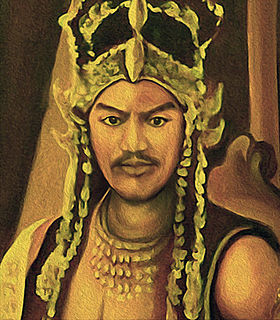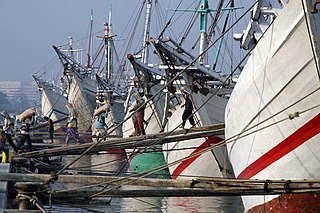 W
WThe Sunda Kingdom was a Sundanese Hindu kingdom located in the western portion of the island of Java from 669 to around 1579, covering the area of present-day Banten, Jakarta, West Java, and the western part of Central Java. The capital of the Sunda Kingdom moved several times during its history, shifting between the Galuh (Kawali) area in the east and Pakuan Pajajaran in the west.
 W
WThe Astana Gede inscriptions, also known as Kawali inscriptions, refers to six inscriptions discovered in Kabuyutan Kawali area, Ciamis Regency, West Java; the main inscription bears the longest scripts. All of the inscriptions were written in Sundanese language and in Sunda script (Kaganga). Although the inscription does not contain chandrasangkala (chronogram), the inscription was thought to be originated from the second half of the 14th century, based on the name of the king mentioned in this inscription.
 W
WThe Batutulis inscription is an ancient Sunda Kingdom inscription dated 1533, located at Batutulis village, South Bogor, West Java. Batutulis inscription is located in the ancient site of the capital Pakuan Pajajaran, Batutulis means 'inscribed stone', it is this stone, still in situ, which gave name to the village. The complex of Batutulis measures 17 x 15 metres. Several other inscribed stones from Sunda Kingdom also located in this location. The inscription was written in Old Sundanese language. The Batutulis inscriptions were created in 1533 by king Surawisesa to honor and commemorate his late father, the great king Sri Baduga Maharaja or known as Ratu Haji Pakuan Pajajaran Sri Sang Ratu Dewata. Sri Baduga Maharaja is also known in local tradition as King Siliwangi.
 W
WKawali was the capital of Sunda Kingdom during Galuh period, between early 14th to late 15th century. It is located in present day Astana Gede archaeological site, Kawali subdistrict, Ciamis Regency, West Java, Indonesia.
 W
WThe Luso-Sundanese padrão is a padrão commemorating a treaty between the kingdoms of Portugal and Sunda, better known as the Luso-Sundanese Treaty of Sunda Kalapa.
 W
WPakuan Pajajaran was the fortified capital city of Sunda kingdom. The location is roughly corresponds to modern Bogor city in West Java, Indonesia, approximately around the site of Batu Tulis. The site is revered as the spiritual home of Sundanese people as it contains much of shared identity and history of Sundanese people.
 W
WParahyangan or Priangan or Preanger is a cultural and mountainous region in West Java province on the island of Java in Indonesia. The Parahyangan area is the heartland of Sundanese culture, the total surface area of this area is approximately a little less than 1/6 of Java. Parahyangan is bordered in the West by the province of Banten, in the North by the northern coast region of Subang, Cirebon and Indramayu, in the east by the province of Central Java, in the south by the Indian Ocean.
 W
WThe Sanghyang Tapak inscription is an ancient inscription dated from 952 saka, consist of 40 lines requiring 4 piece of stone to write on. These 4 stones are found in the Cicatih River bank in Cibadak, Sukabumi, West Java. Three were found near Kampung Bantar Muncang, while one was found near Kampung Pangcalikan. The inscriptions are written in the ancient Javanese Kawi script. Now the four inscriptions are stored at National Museum of Indonesia, with code D 73 (Cicatih), D 96, D 97 and D 98.
 W
WKing Siliwangi or Prabu Siliwangi was a semi-legendary great king of the Hindu Sunda kingdom prior to the coming of Islam in West Java.
 W
WSunda Kelapa is the old port of Jakarta located on the estuarine of Ciliwung River. "Sunda Kalapa" is the original name, and it was the main port of the Sunda Kingdom. The port is situated in Penjaringan sub-district, of North Jakarta, Indonesia. Today the old port only accommodate pinisi, a traditional two masted wooden sailing ship serving inter-island freight service in the archipelago. Although it is now only a minor port, Jakarta has its origins in Sunda Kelapa and it played a significant role in the city's development. The port is currently operated by the state-owned Indonesia Port Corporations.